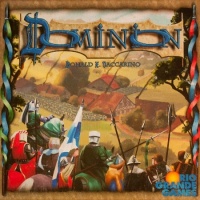
Rolling for Initiative is a weekly column by Scott Thorne, PhD, owner of Castle Perilous Games & Books in Carbondale, Illinois and instructor in marketing at Southeast Missouri State University. This week, Thorne analyzes deck-building games in the light of the product life cycle.
An overheard comment about the introduction of yet another deck-building game to the market set me to thinking about the number of deck-building games, the product life cycle and what the PLC means for this particular segment of the market.
The product life cycle consists of four stages: introduction, growth, maturity and decline. All products go through all four of these stages, some at a faster rate than others (roughly 50,000 new products come onto the market every year, only about 10% of them stay in production for more than five years).
The introductory stage of the PLC is always the most exciting part of a product's life. The manufacturer has this cool new idea for a great new product (Dominion) or an interesting take on an already existing one (Ascension). The manufacturer has (hopefully) playtested it extensively, made mockups or prototypes, lined up a production option, either in-house or outsourced, and lined up financing, again either through itself or, quite commonly today, through an external source such as Kickstarter or Indiegogo. The manufacturer is also all over Twitter, Facebook, TheyTube and any other media venue to which they can get access, talking about this cool new product and trying to get others to do the same. During this stage, while their sales increases hit double or triple percentages, their expenses far exceed their revenues. In short, they are losing money on the product until they hit the breakeven point, at which point their revenues cover their expenses.
Now, they move into the growth stage of the product life cycle. During this stage their promotional efforts slack off as others have, hopefully, picked up on the buzz their original efforts generated for their products. This means less expenditure on promotion, allowing them to divert more of the gross profits to cover fixed costs. If they allocated revenues well, they start making a net profit during this stage. As their product gets wider notice in the market though, sales start to slacken from the triple or high double digit growth they posted after the launch. They should still see growth in the low double digits though.
The characteristic of the growth stage that makes me think the deck-building category is exiting the growth stage and entering the maturity stage of the PLC is that, towards the end of the growth stage, competition products start to enter the market. Competitors see how well this product has done satisfying consumers and want a piece of the action, so they enter the market with similar products, planning to capture a share. Currently, I count a minimum of ten deck-building games on the market, with more on the way. Nothing says more clearly that the market for deck-building games has matured than the number of companies announcing their entry into the market.
What happens during this stage? Profits for early entrants into the market continue to increase as their expenses likewise continue to drop. However, sales increases drop to single digits and start to decline towards the end of the cycle, as the product moves from maturity to decline. One sure sign that the market has moved from maturity to the decline stage of the PLC is competitors pulling the plug on their products and announced product launches never making it to market.
During the decline stage, sales drop, either slightly or precipitously, and they must decide whether the continued sales justify allocating resources to keep the product available or to harvest the product, cease production and direct those resources to another area. Deck-building games are still far from this stage but it will come, likely sooner than expected.


